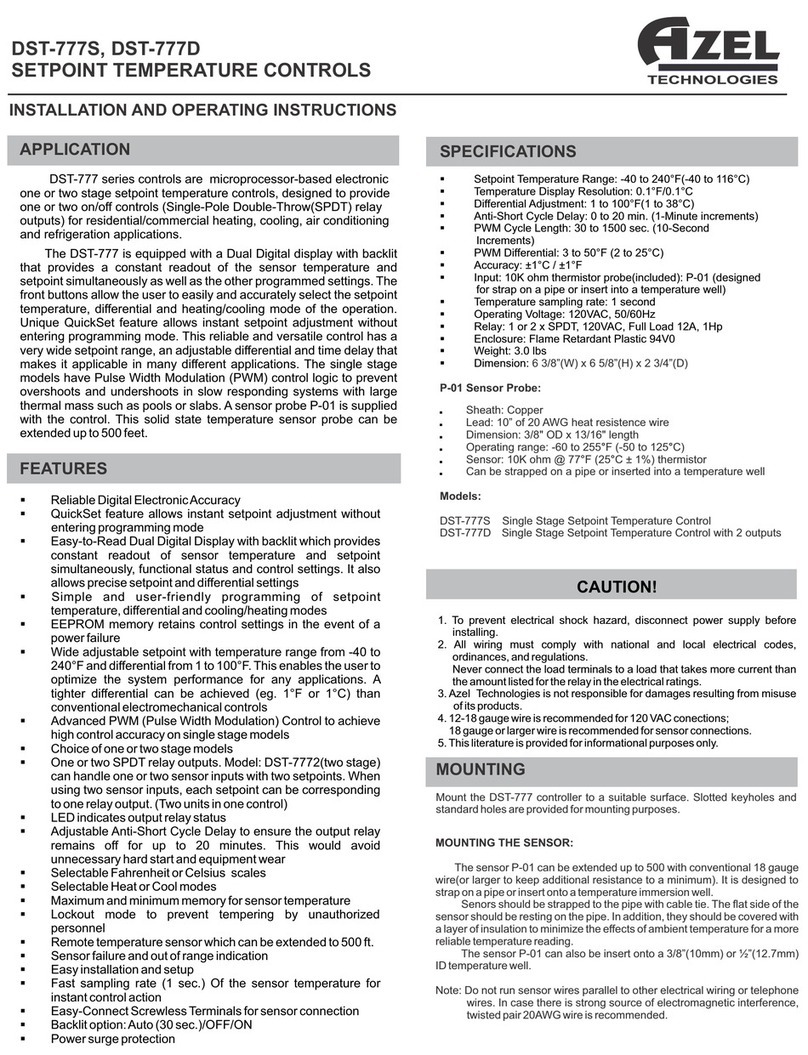
AZEL
TECHNOLOGIES
SETPOINT TEMPERATURE CONTROLS
DST-7772
INSTALLATION AND OPERATING INSTRUCTIONS
§Easy-to-Read Dual Digital Display with backlit which provides
constant readout of sensor temperature and setpoint
simultaneously, functional status and control settings. It also
allows precise setpoint and differential settings
§Wide adjustable setpoint with temperature range from -40 to
240°F and differential from 1 to 100°F. This enables the user to
optimize the system performance for any applications. A
tighter differential can be achieved (eg. 1°F or 1°C) than
conventional electromechanical controls
§LED indicates output relay status
FEATURES
§EEPROM memory retains control settings in the event of a
power failure
§Reliable Digital Electronic Accuracy
§Remote temperature sensor which can be extended to 500 ft.
§Adjustable Anti-Short Cycle Delay to ensure the output relay
remains off for up to 20 minutes. This would avoid
unnecessary hard start and equipment wear
§Maximum and minimum memory for sensor temperature
§Simple and user-friendly programming of setpoint
temperature, differential and cooling/heating modes
§Easy installation and setup
§Selectable Fahrenheit or Celsius scales
§Selectable Heat or Cool modes
§DST-7772can handle one or two sensor inputs with two
setpoints. When using two sensor inputs, each setpoint can
be corresponding to one relay output. (two single stage units
in one control)
§Lockout mode to prevent tempering by unauthorized
personnel
§Sensor failure and out of range indication
§Fast sampling rate (1 sec.) Of the sensor temperature for
instant control action
§Easy-Connect Screwless Terminals for sensor connection
§Backlit option: Auto (30 sec.)/OFF/ON
§Power surge protection
The DST-777 is equipped with a Dual Digital display with backlit
that provides a constant readout of the sensor temperature and
setpoint simultaneously as well as the other programmed settings. The
front buttons allow the user to easily and accurately select the setpoint
temperature, differential and heating/cooling mode of the operation.
This reliable and versatile control has a very wide setpoint range, an
adjustable differential and time delay that makes it applicable in many
different applications. The single stage models have Pulse Width
Modulation (PWM) control logic to prevent overshoots and
undershoots in slow responding systems with large thermal mass such
as pools or slabs. A sensor probe P-01 is supplied with the control. This
solid state temperature sensor probe can be extended up to 500 feet.
DST-777 series controls are microprocessor-based electronic
one or two stage setpoint temperature controls, designed to provide
one or two on/off controls (Single-Pole Double-Throw(SPDT) relay
outputs) for residential/commercial heating, cooling, air conditioning
and refrigeration applications.
APPLICATION
Mount the DST-7772 controller to a suitable surface. Slotted keyholes and
standard holes are provided for mounting purposes.
MOUNTING
SPECIFICATIONS
§Setpoint 1 Temperature Range: -40 to 240°F(-40 to 116°C)
§Setpoint 2 Temperature Range: -40 to 240°F(-40 to 116°C)
§Differential 1 Adjustment: 1 to 100°F(1 to 38°C)
§Differential 2 Adjustment: 1 to 100°F(1 to 38°C)
§Anti-Short Cycle Delay 2: 0 to 20 min. (1-Minute increments)
§Temperature Display Resolution: 0.1°F/0.1°C
§Dimension: 6 3/8”(W) x 6 5/8”(H) x 2 3/4”(D)
§Weight: 3.0 lbs
P-01 Sensor Probe:
§Operating Voltage: 120 VAC, 50/60Hz
,Sheath: Copper
,Lead: 10” of 20 AWG heat resistence wire
,Dimension: 3/8" OD x 13/16" length
,Sensor: 10K ohm @ 77 F (25 C ± 1%) thermistor° °
,Can be strapped on a pipe or inserted into a temperature well
,Operating range: -60 to 255 F (-50 to 125 C) ° °
Models:
§Enclosure: Flame Retardant Plastic 94V0
DST-7772 Two Stage Setpoint Temperature Control
§Anti-Short Cycle Delay 1: 0 to 20 min. (1-Minute increments)
§Accuracy: ±1°C / ±1°F
§Input: 10K ohm thermistor probe(included): P-01 (designed
for strap on a pipe or insert into a temperature well)
§Temperature sampling rate: 1 second
§Relay: 1 or 2 x SPDT, 120VAC, Full Load 12A, 1Hp
CAUTION!
1. To prevent electrical shock hazard, disconnect power supply before
installing.
2. All wiring must comply with national and local electrical codes,
ordinances, and regulations.
4. 12-18 gauge wire is recommended for 120 VAC conections;
5. This literature is provided for informational purposes only.
Never connect the load terminals to a load that takes more current than
the amount listed for the relay in the electrical ratings.
18 gauge or larger wire is recommended for sensor connections.
3. Azel Technologies is not responsible for damages resulting from misuse
of its products.
Note: Do not run sensor wires parallel to other electrical wiring or telephone
wires. In case there is strong source of electromagnetic interference,
twisted pair 20AWG wire is recommended.
The sensor P-01 can be extended up to 500 with conventional 18 gauge
wire(or larger to keep additional resistance to a minimum). It is designed to
strap on a pipe or insert onto a temperature immersion well.
MOUNTING THE SENSOR:
The sensor P-01 can also be insert onto a 3/8”(10mm) or ½”(12.7mm)
ID temperature well.
Senors should be strapped to the pipe with cable tie. The flat side of the
sensor should be resting on the pipe. In addition, they should be covered with
a layer of insulation to minimize the effects of ambient temperature for a more
reliable temperature reading.






















